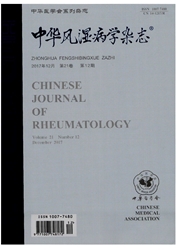

 中文摘要:
中文摘要:
目的观察SSc患者调节性T细胞和辅助性T细胞(Th)17细胞水平、表型和功能的变化,探讨调节性T细胞和Th17细胞及其关系在SSc发病中的作用。方法提取31例SSc患者和33名健康对照者PBMCs,标记CD4、CD25、叉头框蛋白3(FoxP3)、CD45RA、细胞毒T淋巴细胞相关抗原(CTLA)-4及IL-17等荧光抗体,用流式细胞术分析调节性T细胞及表型变化;分选调节性T细胞,用淋巴细胞共培养法鉴定免疫抑制功能;用FlowCytomix检测血清中细胞因子水平;提取细胞mRNA,用实时定量(real-time)-PCR法检测FoxP3、CTLA-4、IL-17A和孤儿核受体RORC mRNA的表达水平。采用独立样本t检验进行统计分析。结果SSc患者调节性T细胞水平高于对照组[(3.6±1.1)%,(2.0±0.8)%,t=6.88,P〈0.01];SSc患者调节性T细胞中CTLA-4的表达低于对照组(P=0.034);SSc患者调节性T细胞中FoxP3和CTLA-4 mRNA的表达较对照组降低(P〈0.05);SSc组调节性T细胞的免疫抑制功能低于对照组(P=0.034)。SSc患者Th17细胞明显高于对照组(P〈0.01);SSc患者血清中IL-17A、IL-22、IL-6和IL-1β的水平高于对照组;SSc患者CD25+FoxP3+IL17+细胞高于对照组[(0.075±0.032)%,(0.049±0.027)%,t=3.52,P=0.029],而CD25+FoxP3+IL-17-与HC组差异无统计学意义。结论SSc患者调节性T细胞和Th17细胞水平同时升高,SSc患者调节性T细胞水平升高,但其表型和功能存在缺陷,FoxP3+IL-17+细胞水平显著增高,调节性T细胞与Th17细胞的平衡关系被打破。
 英文摘要:
英文摘要:
ObjectiveTo investigate the levels, phenotypes and functions of regulatory T cells (Treg) and Th17 cells in systemic sclerosis (SSc) patients and assess the role of imbalance between Treg and Th17 cells in the pathogenesis of SSc.MethodsPeripheral blood mononuclear cells (PBMCs) of 31 SSc patients and 33 healthy controls were analyzed for the expression of CD4, CD25, CD45RA, the cytotoxic T-lymphocyte antigen-4 (CTLA-4), FoxP3, and IL-17 using flow cytometry. Treg immunosuppression capacities were measured in co-cultured experiments. The expressions of IL-17A, IL-22, IL-6 and IL-1β were measured by FlowcytoMix. The expression of FoxP3, CTLA-4, IL-17A, and RORC mRNA were measured by real-time polymerase chain reaction (PCR). The independent samples t-test was used to compare data between the groups.ResultsThe frequency of Treg cells was significantly elevated in SSc [(3.6±1.1)%] compared with controls [(2.0±0.8)%, t=6.88, P〈0.01)] and the expression of CTLA-4 was lower in Treg cells of SSc (P=0.034). The expression of CTLA-4 and FoxP3 mRNA was lower in SSc compared with controls(P〈0.05), the immunosuppressive capacity of Treg cells were diminished in SSc (P=0.034). Th17 cells were increased in SSc (P〈0.01); the levels of IL-17A, IL-22, IL-6 and IL-1β in the serums of SSc were higher than the controls(P〈0.05). In SSc, CD25+FoxP3+IL-17+ cells were increased [0.075%±0.032)% vs (0.049±0.027)%, t=3.52, P=0.029], but no difference of CD25+FoxP3+IL-17- was observed when compared with control. The expression of IL-17A and RORC mRNA were increased in SSc (P〈0.01, respectively).ConclusionBoth Treg and Th17 cells are increased in patients of SSc. Treg increases along with the deficiency of phenotype and function. FoxP3+IL-17+ co-express cells are increased, and the balance between Treg and Th17 cells is broken.
 同期刊论文项目
同期刊论文项目
 同项目期刊论文
同项目期刊论文
 Prevalence and clinical importance of gastroesophageal reflux in Chinese patients with systemic scle
Prevalence and clinical importance of gastroesophageal reflux in Chinese patients with systemic scle 期刊信息
期刊信息
